Strategy as Idea: Elements, Benefits, and Drawbacks
VerifiedAdded on 2022/11/29
|9
|2697
|413
AI Summary
This report explores the concept of strategy as an idea, focusing on its elements, benefits, and drawbacks. It discusses the importance of variety, creating context, and adaptive tension in this approach. The report also critically discusses the strategic lens of ideas and compares it to deliberate strategy. Furthermore, it highlights the benefits and drawbacks of the idea strategic lens and its implications for an entrepreneurial organization. The case study of Sainsbury, the second largest retail organization in the UK, is used to illustrate the application of this strategic lens.
Contribute Materials
Your contribution can guide someone’s learning journey. Share your
documents today.
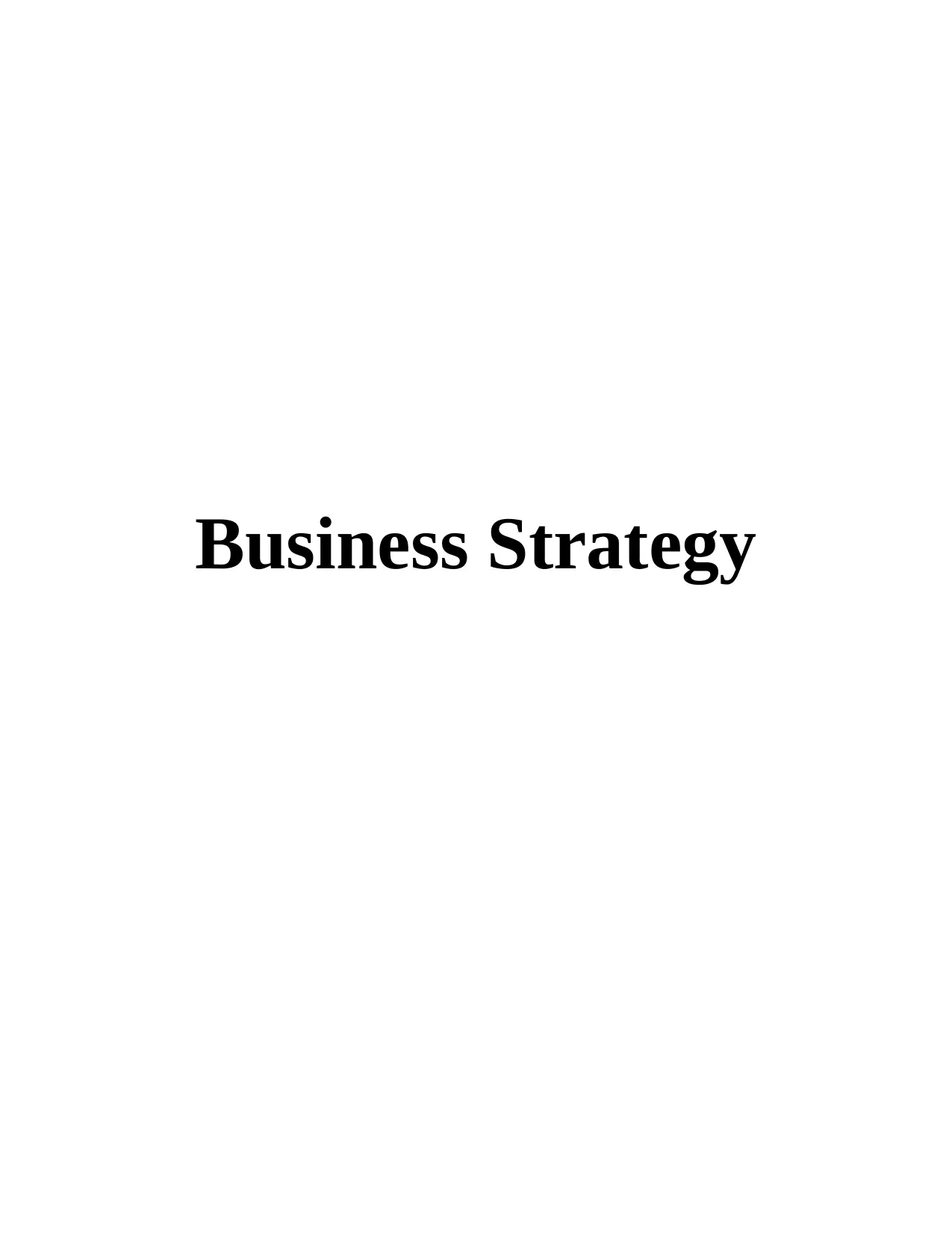
Business Strategy
Secure Best Marks with AI Grader
Need help grading? Try our AI Grader for instant feedback on your assignments.
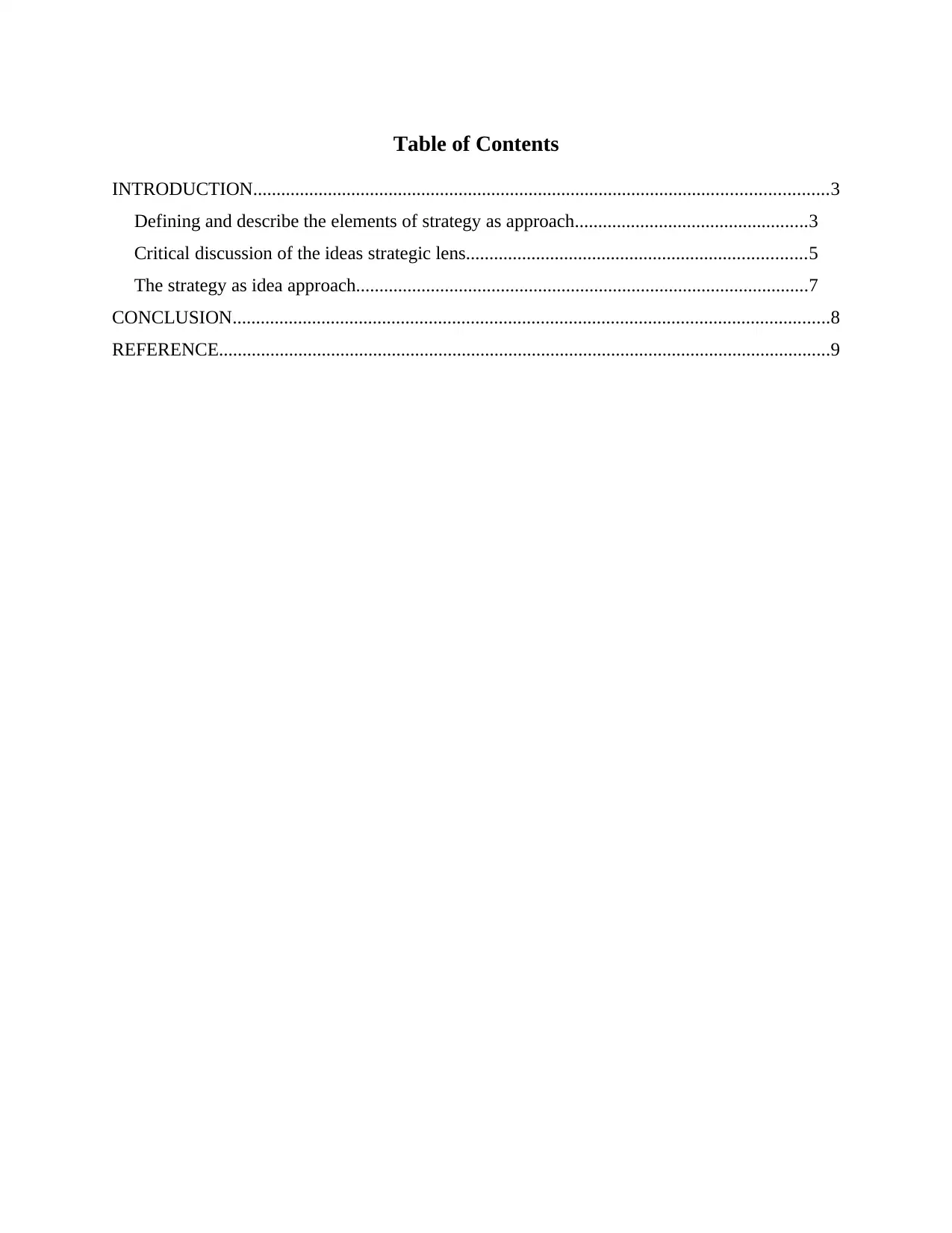
Table of Contents
INTRODUCTION...........................................................................................................................3
Defining and describe the elements of strategy as approach..................................................3
Critical discussion of the ideas strategic lens.........................................................................5
The strategy as idea approach.................................................................................................7
CONCLUSION................................................................................................................................8
REFERENCE...................................................................................................................................9
INTRODUCTION...........................................................................................................................3
Defining and describe the elements of strategy as approach..................................................3
Critical discussion of the ideas strategic lens.........................................................................5
The strategy as idea approach.................................................................................................7
CONCLUSION................................................................................................................................8
REFERENCE...................................................................................................................................9
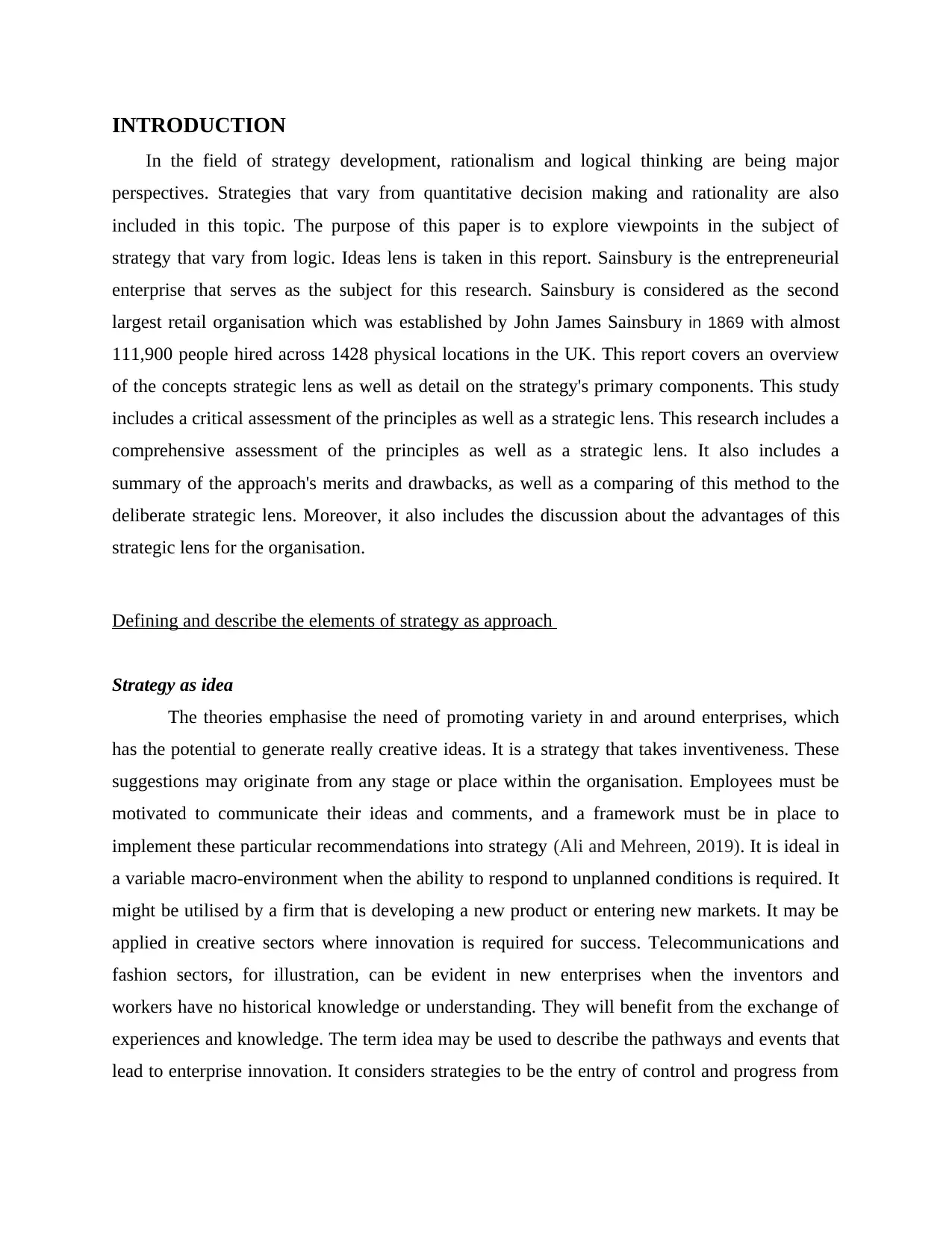
INTRODUCTION
In the field of strategy development, rationalism and logical thinking are being major
perspectives. Strategies that vary from quantitative decision making and rationality are also
included in this topic. The purpose of this paper is to explore viewpoints in the subject of
strategy that vary from logic. Ideas lens is taken in this report. Sainsbury is the entrepreneurial
enterprise that serves as the subject for this research. Sainsbury is considered as the second
largest retail organisation which was established by John James Sainsbury in 1869 with almost
111,900 people hired across 1428 physical locations in the UK. This report covers an overview
of the concepts strategic lens as well as detail on the strategy's primary components. This study
includes a critical assessment of the principles as well as a strategic lens. This research includes a
comprehensive assessment of the principles as well as a strategic lens. It also includes a
summary of the approach's merits and drawbacks, as well as a comparing of this method to the
deliberate strategic lens. Moreover, it also includes the discussion about the advantages of this
strategic lens for the organisation.
Defining and describe the elements of strategy as approach
Strategy as idea
The theories emphasise the need of promoting variety in and around enterprises, which
has the potential to generate really creative ideas. It is a strategy that takes inventiveness. These
suggestions may originate from any stage or place within the organisation. Employees must be
motivated to communicate their ideas and comments, and a framework must be in place to
implement these particular recommendations into strategy (Ali and Mehreen, 2019). It is ideal in
a variable macro-environment when the ability to respond to unplanned conditions is required. It
might be utilised by a firm that is developing a new product or entering new markets. It may be
applied in creative sectors where innovation is required for success. Telecommunications and
fashion sectors, for illustration, can be evident in new enterprises when the inventors and
workers have no historical knowledge or understanding. They will benefit from the exchange of
experiences and knowledge. The term idea may be used to describe the pathways and events that
lead to enterprise innovation. It considers strategies to be the entry of control and progress from
In the field of strategy development, rationalism and logical thinking are being major
perspectives. Strategies that vary from quantitative decision making and rationality are also
included in this topic. The purpose of this paper is to explore viewpoints in the subject of
strategy that vary from logic. Ideas lens is taken in this report. Sainsbury is the entrepreneurial
enterprise that serves as the subject for this research. Sainsbury is considered as the second
largest retail organisation which was established by John James Sainsbury in 1869 with almost
111,900 people hired across 1428 physical locations in the UK. This report covers an overview
of the concepts strategic lens as well as detail on the strategy's primary components. This study
includes a critical assessment of the principles as well as a strategic lens. This research includes a
comprehensive assessment of the principles as well as a strategic lens. It also includes a
summary of the approach's merits and drawbacks, as well as a comparing of this method to the
deliberate strategic lens. Moreover, it also includes the discussion about the advantages of this
strategic lens for the organisation.
Defining and describe the elements of strategy as approach
Strategy as idea
The theories emphasise the need of promoting variety in and around enterprises, which
has the potential to generate really creative ideas. It is a strategy that takes inventiveness. These
suggestions may originate from any stage or place within the organisation. Employees must be
motivated to communicate their ideas and comments, and a framework must be in place to
implement these particular recommendations into strategy (Ali and Mehreen, 2019). It is ideal in
a variable macro-environment when the ability to respond to unplanned conditions is required. It
might be utilised by a firm that is developing a new product or entering new markets. It may be
applied in creative sectors where innovation is required for success. Telecommunications and
fashion sectors, for illustration, can be evident in new enterprises when the inventors and
workers have no historical knowledge or understanding. They will benefit from the exchange of
experiences and knowledge. The term idea may be used to describe the pathways and events that
lead to enterprise innovation. It considers strategies to be the entry of control and progress from
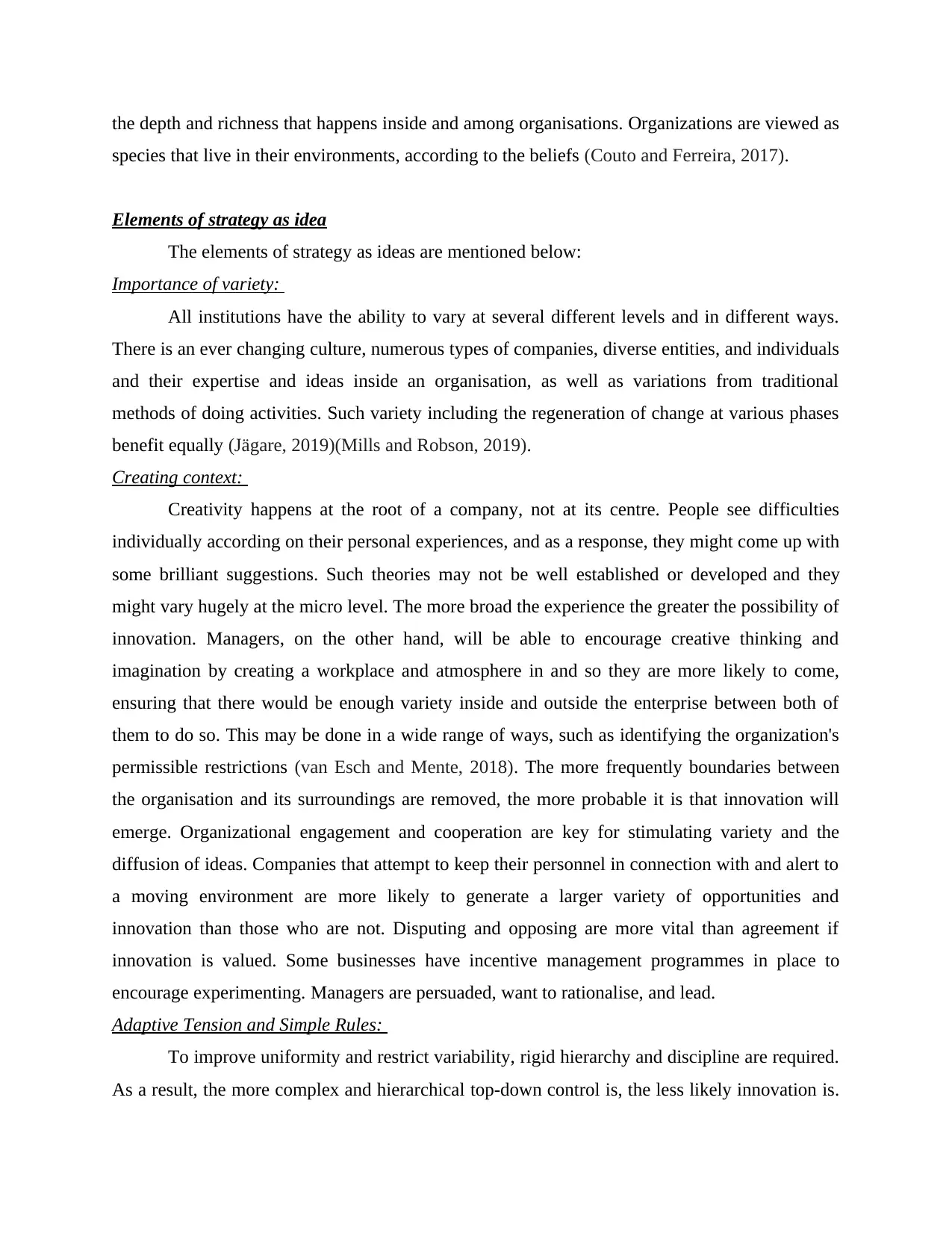
the depth and richness that happens inside and among organisations. Organizations are viewed as
species that live in their environments, according to the beliefs (Couto and Ferreira, 2017).
Elements of strategy as idea
The elements of strategy as ideas are mentioned below:
Importance of variety:
All institutions have the ability to vary at several different levels and in different ways.
There is an ever changing culture, numerous types of companies, diverse entities, and individuals
and their expertise and ideas inside an organisation, as well as variations from traditional
methods of doing activities. Such variety including the regeneration of change at various phases
benefit equally (Jägare, 2019)(Mills and Robson, 2019).
Creating context:
Creativity happens at the root of a company, not at its centre. People see difficulties
individually according on their personal experiences, and as a response, they might come up with
some brilliant suggestions. Such theories may not be well established or developed and they
might vary hugely at the micro level. The more broad the experience the greater the possibility of
innovation. Managers, on the other hand, will be able to encourage creative thinking and
imagination by creating a workplace and atmosphere in and so they are more likely to come,
ensuring that there would be enough variety inside and outside the enterprise between both of
them to do so. This may be done in a wide range of ways, such as identifying the organization's
permissible restrictions (van Esch and Mente, 2018). The more frequently boundaries between
the organisation and its surroundings are removed, the more probable it is that innovation will
emerge. Organizational engagement and cooperation are key for stimulating variety and the
diffusion of ideas. Companies that attempt to keep their personnel in connection with and alert to
a moving environment are more likely to generate a larger variety of opportunities and
innovation than those who are not. Disputing and opposing are more vital than agreement if
innovation is valued. Some businesses have incentive management programmes in place to
encourage experimenting. Managers are persuaded, want to rationalise, and lead.
Adaptive Tension and Simple Rules:
To improve uniformity and restrict variability, rigid hierarchy and discipline are required.
As a result, the more complex and hierarchical top-down control is, the less likely innovation is.
species that live in their environments, according to the beliefs (Couto and Ferreira, 2017).
Elements of strategy as idea
The elements of strategy as ideas are mentioned below:
Importance of variety:
All institutions have the ability to vary at several different levels and in different ways.
There is an ever changing culture, numerous types of companies, diverse entities, and individuals
and their expertise and ideas inside an organisation, as well as variations from traditional
methods of doing activities. Such variety including the regeneration of change at various phases
benefit equally (Jägare, 2019)(Mills and Robson, 2019).
Creating context:
Creativity happens at the root of a company, not at its centre. People see difficulties
individually according on their personal experiences, and as a response, they might come up with
some brilliant suggestions. Such theories may not be well established or developed and they
might vary hugely at the micro level. The more broad the experience the greater the possibility of
innovation. Managers, on the other hand, will be able to encourage creative thinking and
imagination by creating a workplace and atmosphere in and so they are more likely to come,
ensuring that there would be enough variety inside and outside the enterprise between both of
them to do so. This may be done in a wide range of ways, such as identifying the organization's
permissible restrictions (van Esch and Mente, 2018). The more frequently boundaries between
the organisation and its surroundings are removed, the more probable it is that innovation will
emerge. Organizational engagement and cooperation are key for stimulating variety and the
diffusion of ideas. Companies that attempt to keep their personnel in connection with and alert to
a moving environment are more likely to generate a larger variety of opportunities and
innovation than those who are not. Disputing and opposing are more vital than agreement if
innovation is valued. Some businesses have incentive management programmes in place to
encourage experimenting. Managers are persuaded, want to rationalise, and lead.
Adaptive Tension and Simple Rules:
To improve uniformity and restrict variability, rigid hierarchy and discipline are required.
As a result, the more complex and hierarchical top-down control is, the less likely innovation is.
Secure Best Marks with AI Grader
Need help grading? Try our AI Grader for instant feedback on your assignments.
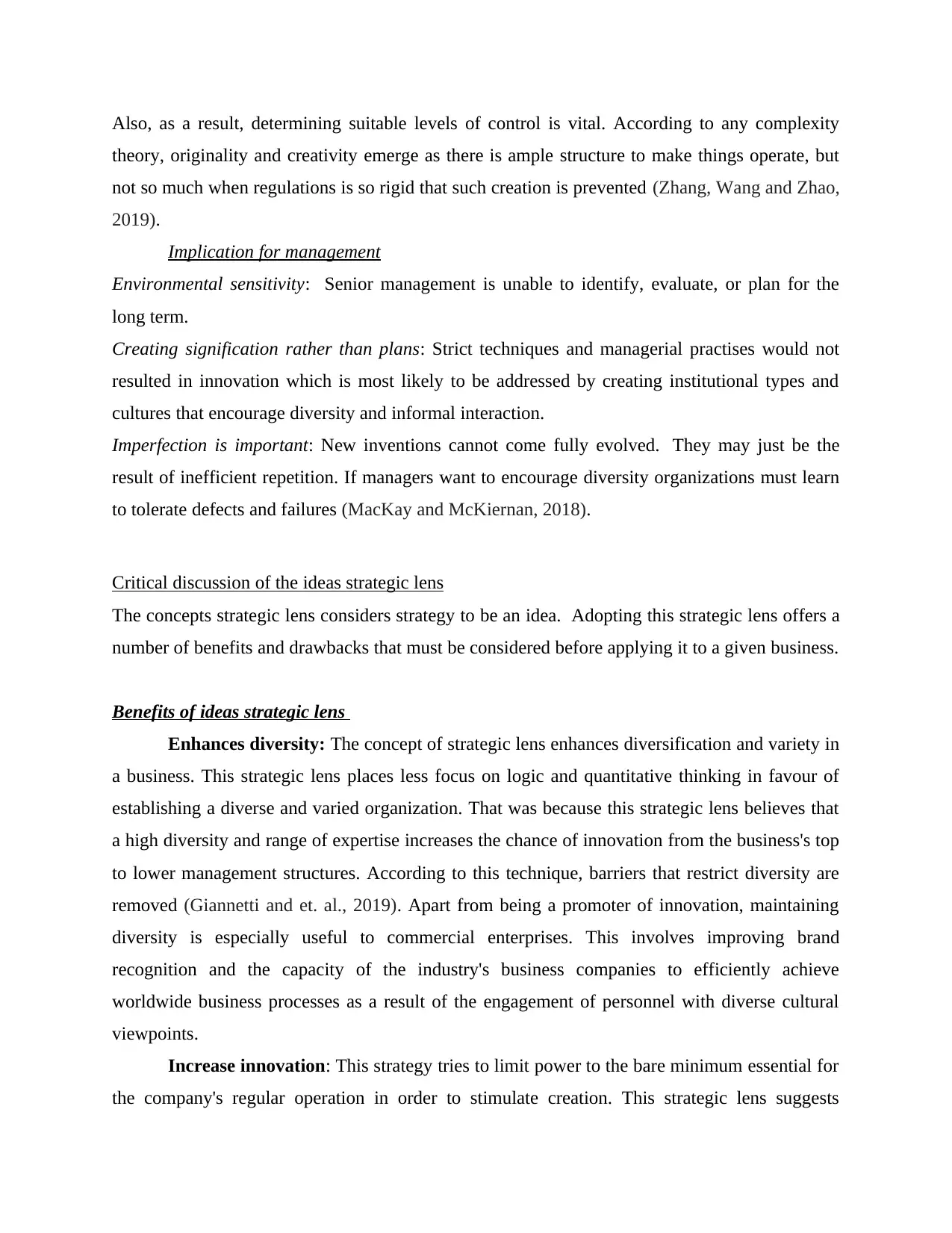
Also, as a result, determining suitable levels of control is vital. According to any complexity
theory, originality and creativity emerge as there is ample structure to make things operate, but
not so much when regulations is so rigid that such creation is prevented (Zhang, Wang and Zhao,
2019).
Implication for management
Environmental sensitivity: Senior management is unable to identify, evaluate, or plan for the
long term.
Creating signification rather than plans: Strict techniques and managerial practises would not
resulted in innovation which is most likely to be addressed by creating institutional types and
cultures that encourage diversity and informal interaction.
Imperfection is important: New inventions cannot come fully evolved. They may just be the
result of inefficient repetition. If managers want to encourage diversity organizations must learn
to tolerate defects and failures (MacKay and McKiernan, 2018).
Critical discussion of the ideas strategic lens
The concepts strategic lens considers strategy to be an idea. Adopting this strategic lens offers a
number of benefits and drawbacks that must be considered before applying it to a given business.
Benefits of ideas strategic lens
Enhances diversity: The concept of strategic lens enhances diversification and variety in
a business. This strategic lens places less focus on logic and quantitative thinking in favour of
establishing a diverse and varied organization. That was because this strategic lens believes that
a high diversity and range of expertise increases the chance of innovation from the business's top
to lower management structures. According to this technique, barriers that restrict diversity are
removed (Giannetti and et. al., 2019). Apart from being a promoter of innovation, maintaining
diversity is especially useful to commercial enterprises. This involves improving brand
recognition and the capacity of the industry's business companies to efficiently achieve
worldwide business processes as a result of the engagement of personnel with diverse cultural
viewpoints.
Increase innovation: This strategy tries to limit power to the bare minimum essential for
the company's regular operation in order to stimulate creation. This strategic lens suggests
theory, originality and creativity emerge as there is ample structure to make things operate, but
not so much when regulations is so rigid that such creation is prevented (Zhang, Wang and Zhao,
2019).
Implication for management
Environmental sensitivity: Senior management is unable to identify, evaluate, or plan for the
long term.
Creating signification rather than plans: Strict techniques and managerial practises would not
resulted in innovation which is most likely to be addressed by creating institutional types and
cultures that encourage diversity and informal interaction.
Imperfection is important: New inventions cannot come fully evolved. They may just be the
result of inefficient repetition. If managers want to encourage diversity organizations must learn
to tolerate defects and failures (MacKay and McKiernan, 2018).
Critical discussion of the ideas strategic lens
The concepts strategic lens considers strategy to be an idea. Adopting this strategic lens offers a
number of benefits and drawbacks that must be considered before applying it to a given business.
Benefits of ideas strategic lens
Enhances diversity: The concept of strategic lens enhances diversification and variety in
a business. This strategic lens places less focus on logic and quantitative thinking in favour of
establishing a diverse and varied organization. That was because this strategic lens believes that
a high diversity and range of expertise increases the chance of innovation from the business's top
to lower management structures. According to this technique, barriers that restrict diversity are
removed (Giannetti and et. al., 2019). Apart from being a promoter of innovation, maintaining
diversity is especially useful to commercial enterprises. This involves improving brand
recognition and the capacity of the industry's business companies to efficiently achieve
worldwide business processes as a result of the engagement of personnel with diverse cultural
viewpoints.
Increase innovation: This strategy tries to limit power to the bare minimum essential for
the company's regular operation in order to stimulate creation. This strategic lens suggests
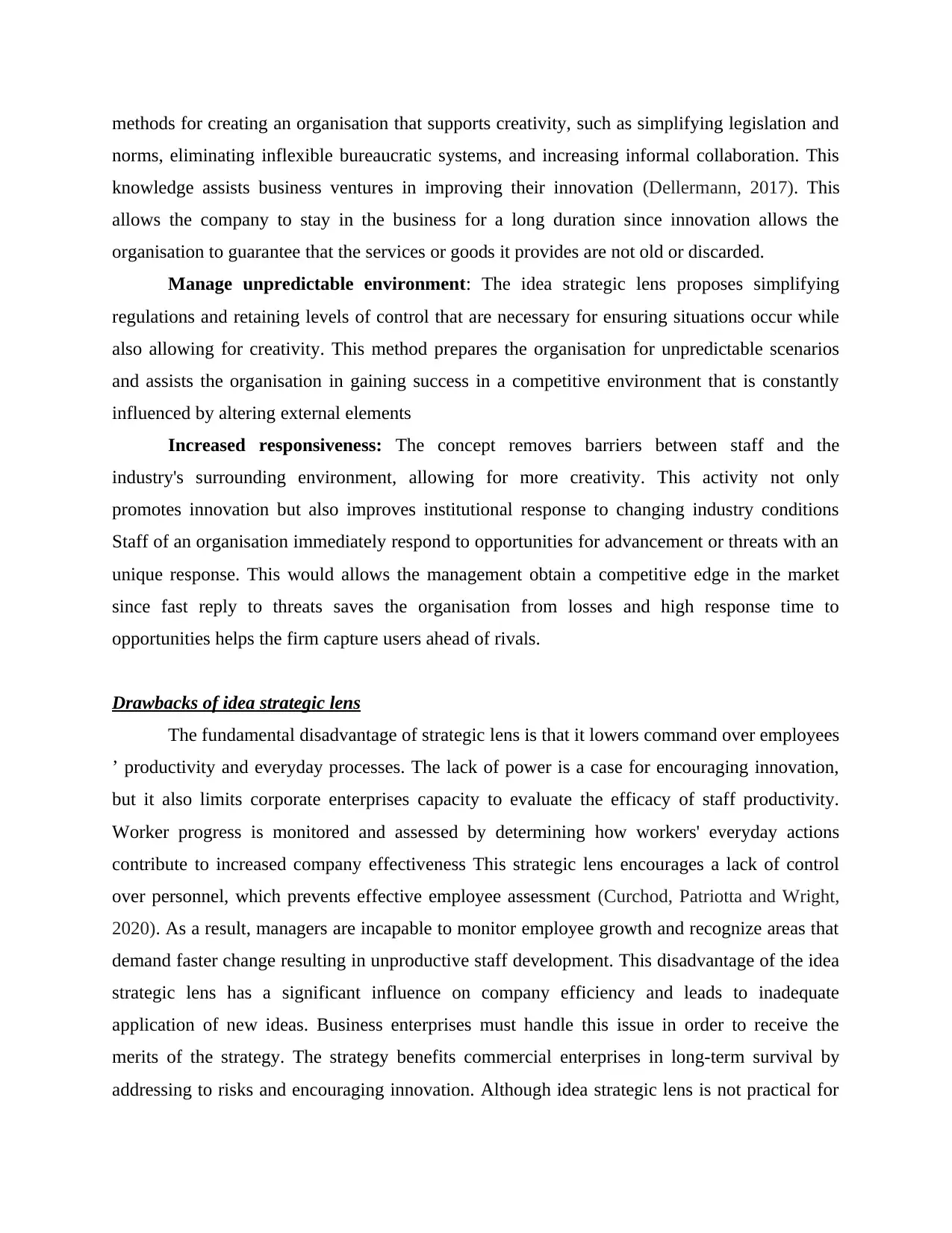
methods for creating an organisation that supports creativity, such as simplifying legislation and
norms, eliminating inflexible bureaucratic systems, and increasing informal collaboration. This
knowledge assists business ventures in improving their innovation (Dellermann, 2017). This
allows the company to stay in the business for a long duration since innovation allows the
organisation to guarantee that the services or goods it provides are not old or discarded.
Manage unpredictable environment: The idea strategic lens proposes simplifying
regulations and retaining levels of control that are necessary for ensuring situations occur while
also allowing for creativity. This method prepares the organisation for unpredictable scenarios
and assists the organisation in gaining success in a competitive environment that is constantly
influenced by altering external elements
Increased responsiveness: The concept removes barriers between staff and the
industry's surrounding environment, allowing for more creativity. This activity not only
promotes innovation but also improves institutional response to changing industry conditions
Staff of an organisation immediately respond to opportunities for advancement or threats with an
unique response. This would allows the management obtain a competitive edge in the market
since fast reply to threats saves the organisation from losses and high response time to
opportunities helps the firm capture users ahead of rivals.
Drawbacks of idea strategic lens
The fundamental disadvantage of strategic lens is that it lowers command over employees
’ productivity and everyday processes. The lack of power is a case for encouraging innovation,
but it also limits corporate enterprises capacity to evaluate the efficacy of staff productivity.
Worker progress is monitored and assessed by determining how workers' everyday actions
contribute to increased company effectiveness This strategic lens encourages a lack of control
over personnel, which prevents effective employee assessment (Curchod, Patriotta and Wright,
2020). As a result, managers are incapable to monitor employee growth and recognize areas that
demand faster change resulting in unproductive staff development. This disadvantage of the idea
strategic lens has a significant influence on company efficiency and leads to inadequate
application of new ideas. Business enterprises must handle this issue in order to receive the
merits of the strategy. The strategy benefits commercial enterprises in long-term survival by
addressing to risks and encouraging innovation. Although idea strategic lens is not practical for
norms, eliminating inflexible bureaucratic systems, and increasing informal collaboration. This
knowledge assists business ventures in improving their innovation (Dellermann, 2017). This
allows the company to stay in the business for a long duration since innovation allows the
organisation to guarantee that the services or goods it provides are not old or discarded.
Manage unpredictable environment: The idea strategic lens proposes simplifying
regulations and retaining levels of control that are necessary for ensuring situations occur while
also allowing for creativity. This method prepares the organisation for unpredictable scenarios
and assists the organisation in gaining success in a competitive environment that is constantly
influenced by altering external elements
Increased responsiveness: The concept removes barriers between staff and the
industry's surrounding environment, allowing for more creativity. This activity not only
promotes innovation but also improves institutional response to changing industry conditions
Staff of an organisation immediately respond to opportunities for advancement or threats with an
unique response. This would allows the management obtain a competitive edge in the market
since fast reply to threats saves the organisation from losses and high response time to
opportunities helps the firm capture users ahead of rivals.
Drawbacks of idea strategic lens
The fundamental disadvantage of strategic lens is that it lowers command over employees
’ productivity and everyday processes. The lack of power is a case for encouraging innovation,
but it also limits corporate enterprises capacity to evaluate the efficacy of staff productivity.
Worker progress is monitored and assessed by determining how workers' everyday actions
contribute to increased company effectiveness This strategic lens encourages a lack of control
over personnel, which prevents effective employee assessment (Curchod, Patriotta and Wright,
2020). As a result, managers are incapable to monitor employee growth and recognize areas that
demand faster change resulting in unproductive staff development. This disadvantage of the idea
strategic lens has a significant influence on company efficiency and leads to inadequate
application of new ideas. Business enterprises must handle this issue in order to receive the
merits of the strategy. The strategy benefits commercial enterprises in long-term survival by
addressing to risks and encouraging innovation. Although idea strategic lens is not practical for
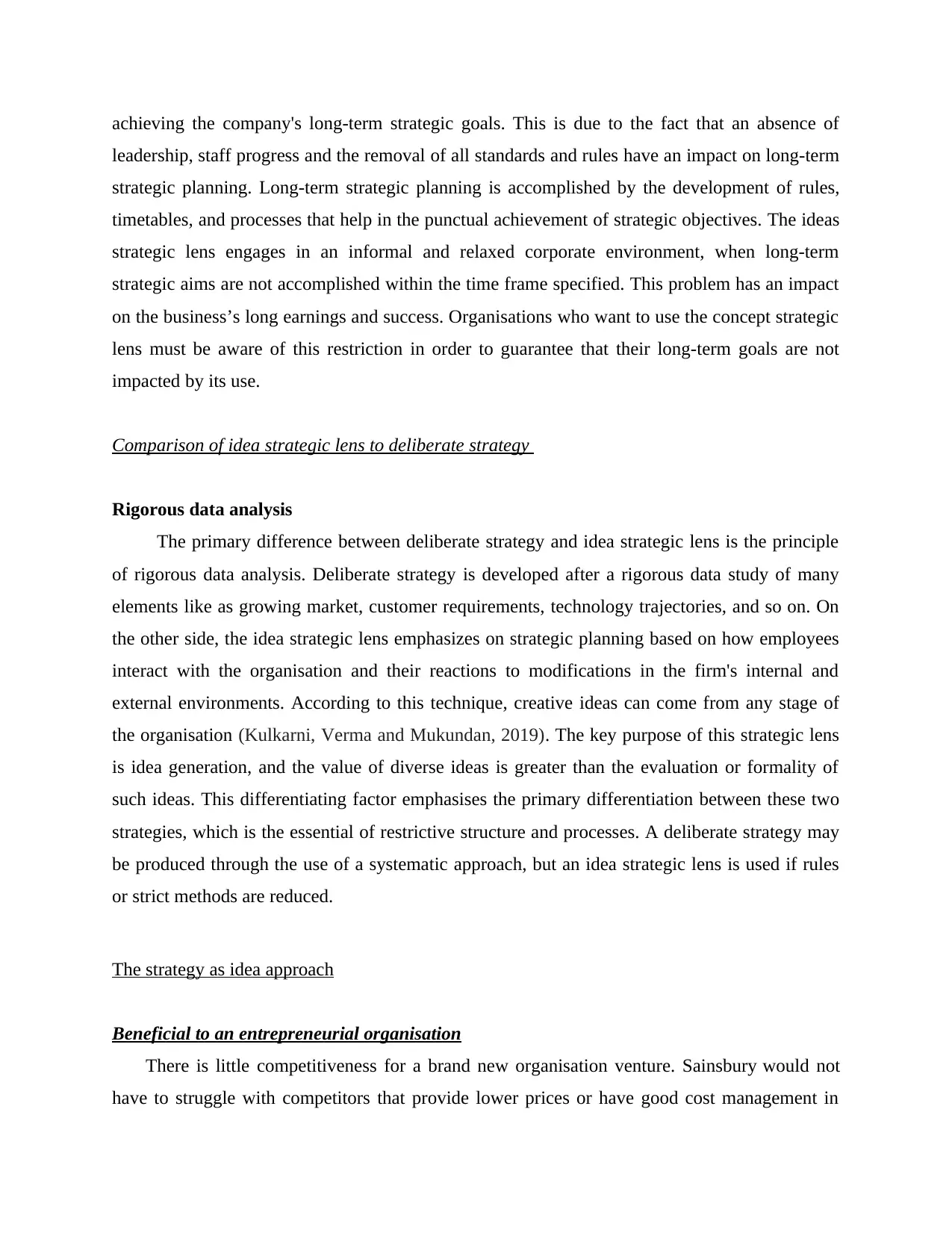
achieving the company's long-term strategic goals. This is due to the fact that an absence of
leadership, staff progress and the removal of all standards and rules have an impact on long-term
strategic planning. Long-term strategic planning is accomplished by the development of rules,
timetables, and processes that help in the punctual achievement of strategic objectives. The ideas
strategic lens engages in an informal and relaxed corporate environment, when long-term
strategic aims are not accomplished within the time frame specified. This problem has an impact
on the business’s long earnings and success. Organisations who want to use the concept strategic
lens must be aware of this restriction in order to guarantee that their long-term goals are not
impacted by its use.
Comparison of idea strategic lens to deliberate strategy
Rigorous data analysis
The primary difference between deliberate strategy and idea strategic lens is the principle
of rigorous data analysis. Deliberate strategy is developed after a rigorous data study of many
elements like as growing market, customer requirements, technology trajectories, and so on. On
the other side, the idea strategic lens emphasizes on strategic planning based on how employees
interact with the organisation and their reactions to modifications in the firm's internal and
external environments. According to this technique, creative ideas can come from any stage of
the organisation (Kulkarni, Verma and Mukundan, 2019). The key purpose of this strategic lens
is idea generation, and the value of diverse ideas is greater than the evaluation or formality of
such ideas. This differentiating factor emphasises the primary differentiation between these two
strategies, which is the essential of restrictive structure and processes. A deliberate strategy may
be produced through the use of a systematic approach, but an idea strategic lens is used if rules
or strict methods are reduced.
The strategy as idea approach
Beneficial to an entrepreneurial organisation
There is little competitiveness for a brand new organisation venture. Sainsbury would not
have to struggle with competitors that provide lower prices or have good cost management in
leadership, staff progress and the removal of all standards and rules have an impact on long-term
strategic planning. Long-term strategic planning is accomplished by the development of rules,
timetables, and processes that help in the punctual achievement of strategic objectives. The ideas
strategic lens engages in an informal and relaxed corporate environment, when long-term
strategic aims are not accomplished within the time frame specified. This problem has an impact
on the business’s long earnings and success. Organisations who want to use the concept strategic
lens must be aware of this restriction in order to guarantee that their long-term goals are not
impacted by its use.
Comparison of idea strategic lens to deliberate strategy
Rigorous data analysis
The primary difference between deliberate strategy and idea strategic lens is the principle
of rigorous data analysis. Deliberate strategy is developed after a rigorous data study of many
elements like as growing market, customer requirements, technology trajectories, and so on. On
the other side, the idea strategic lens emphasizes on strategic planning based on how employees
interact with the organisation and their reactions to modifications in the firm's internal and
external environments. According to this technique, creative ideas can come from any stage of
the organisation (Kulkarni, Verma and Mukundan, 2019). The key purpose of this strategic lens
is idea generation, and the value of diverse ideas is greater than the evaluation or formality of
such ideas. This differentiating factor emphasises the primary differentiation between these two
strategies, which is the essential of restrictive structure and processes. A deliberate strategy may
be produced through the use of a systematic approach, but an idea strategic lens is used if rules
or strict methods are reduced.
The strategy as idea approach
Beneficial to an entrepreneurial organisation
There is little competitiveness for a brand new organisation venture. Sainsbury would not
have to struggle with competitors that provide lower prices or have good cost management in
Paraphrase This Document
Need a fresh take? Get an instant paraphrase of this document with our AI Paraphraser
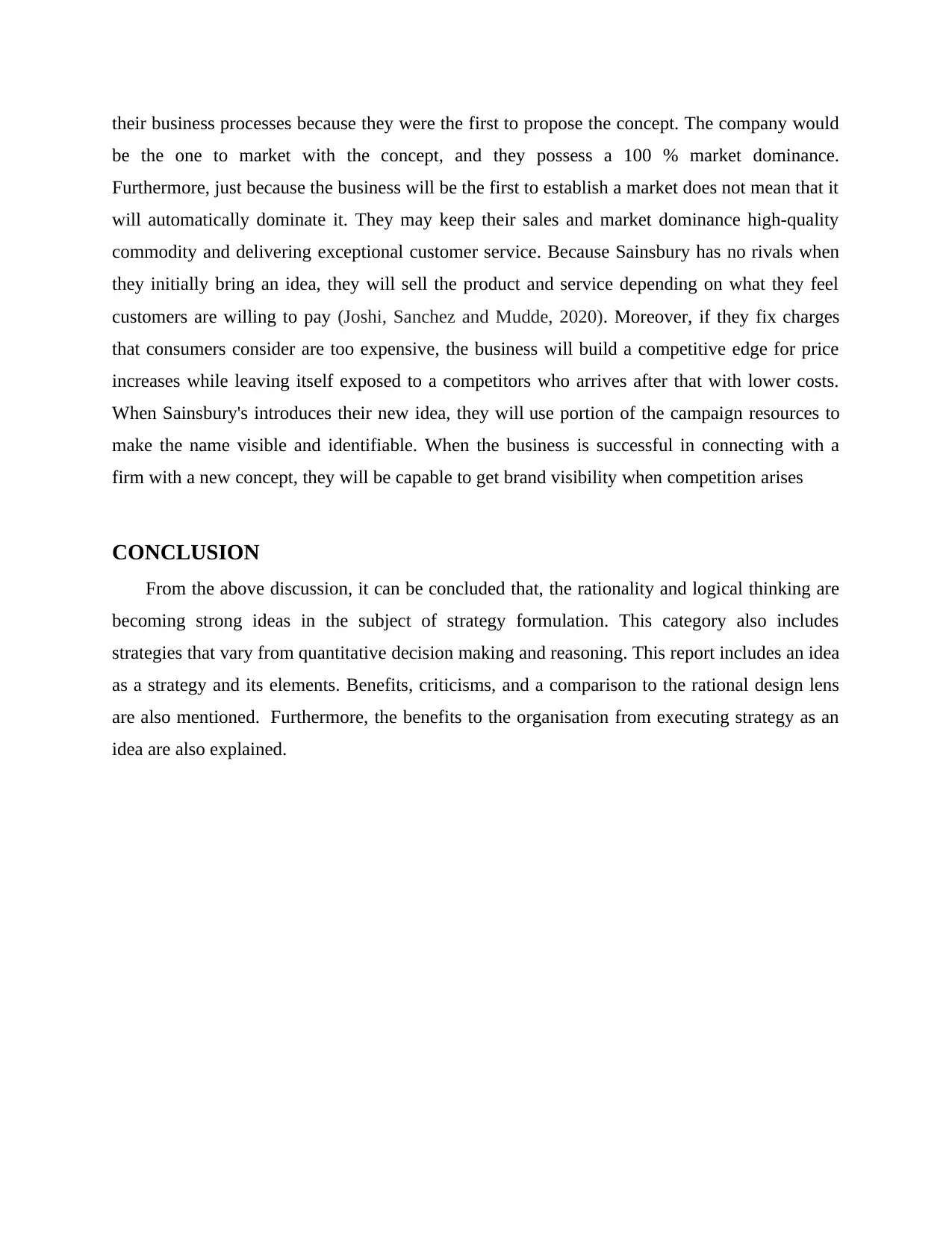
their business processes because they were the first to propose the concept. The company would
be the one to market with the concept, and they possess a 100 % market dominance.
Furthermore, just because the business will be the first to establish a market does not mean that it
will automatically dominate it. They may keep their sales and market dominance high-quality
commodity and delivering exceptional customer service. Because Sainsbury has no rivals when
they initially bring an idea, they will sell the product and service depending on what they feel
customers are willing to pay (Joshi, Sanchez and Mudde, 2020). Moreover, if they fix charges
that consumers consider are too expensive, the business will build a competitive edge for price
increases while leaving itself exposed to a competitors who arrives after that with lower costs.
When Sainsbury's introduces their new idea, they will use portion of the campaign resources to
make the name visible and identifiable. When the business is successful in connecting with a
firm with a new concept, they will be capable to get brand visibility when competition arises
CONCLUSION
From the above discussion, it can be concluded that, the rationality and logical thinking are
becoming strong ideas in the subject of strategy formulation. This category also includes
strategies that vary from quantitative decision making and reasoning. This report includes an idea
as a strategy and its elements. Benefits, criticisms, and a comparison to the rational design lens
are also mentioned. Furthermore, the benefits to the organisation from executing strategy as an
idea are also explained.
be the one to market with the concept, and they possess a 100 % market dominance.
Furthermore, just because the business will be the first to establish a market does not mean that it
will automatically dominate it. They may keep their sales and market dominance high-quality
commodity and delivering exceptional customer service. Because Sainsbury has no rivals when
they initially bring an idea, they will sell the product and service depending on what they feel
customers are willing to pay (Joshi, Sanchez and Mudde, 2020). Moreover, if they fix charges
that consumers consider are too expensive, the business will build a competitive edge for price
increases while leaving itself exposed to a competitors who arrives after that with lower costs.
When Sainsbury's introduces their new idea, they will use portion of the campaign resources to
make the name visible and identifiable. When the business is successful in connecting with a
firm with a new concept, they will be capable to get brand visibility when competition arises
CONCLUSION
From the above discussion, it can be concluded that, the rationality and logical thinking are
becoming strong ideas in the subject of strategy formulation. This category also includes
strategies that vary from quantitative decision making and reasoning. This report includes an idea
as a strategy and its elements. Benefits, criticisms, and a comparison to the rational design lens
are also mentioned. Furthermore, the benefits to the organisation from executing strategy as an
idea are also explained.
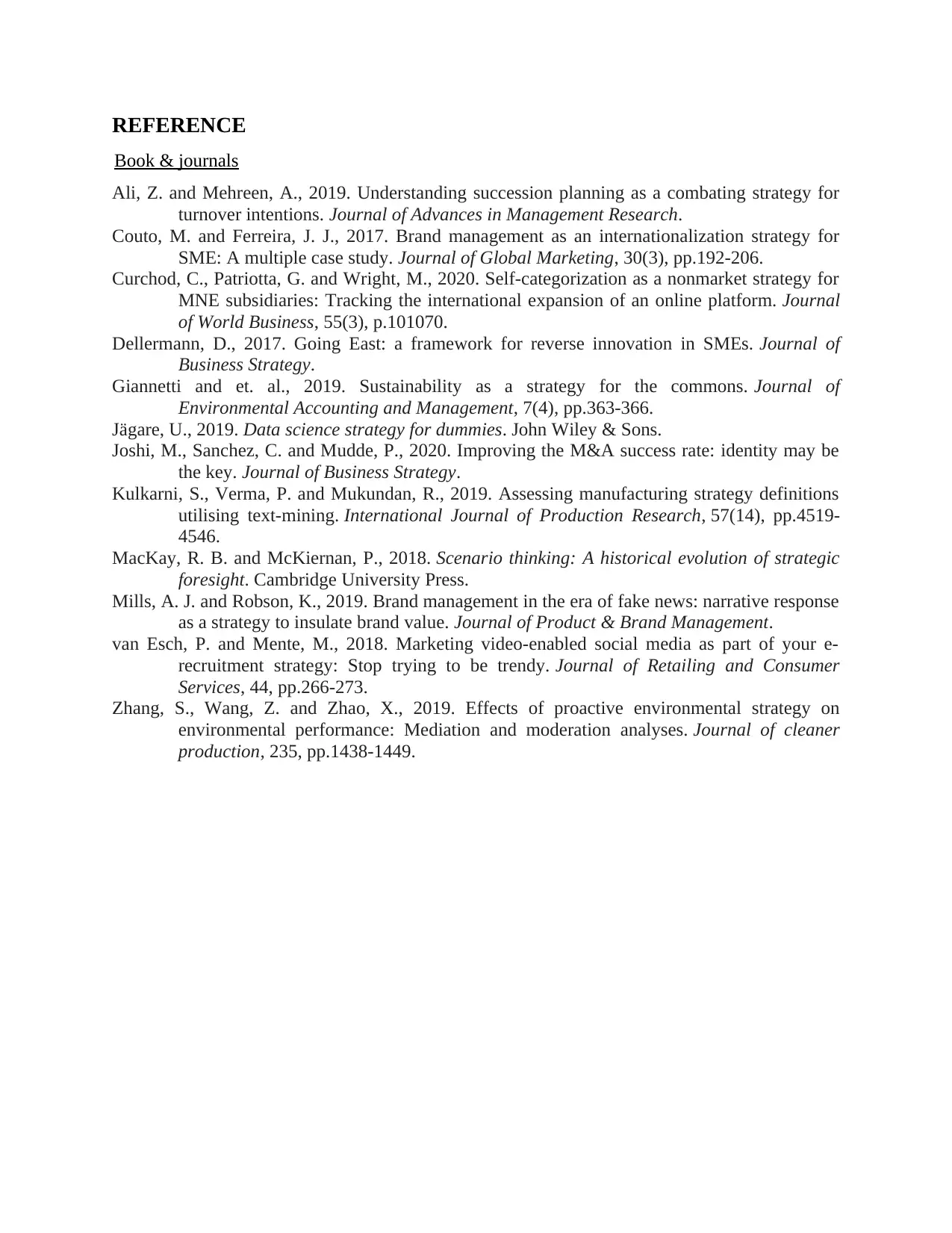
REFERENCE
Book & journals
Ali, Z. and Mehreen, A., 2019. Understanding succession planning as a combating strategy for
turnover intentions. Journal of Advances in Management Research.
Couto, M. and Ferreira, J. J., 2017. Brand management as an internationalization strategy for
SME: A multiple case study. Journal of Global Marketing, 30(3), pp.192-206.
Curchod, C., Patriotta, G. and Wright, M., 2020. Self-categorization as a nonmarket strategy for
MNE subsidiaries: Tracking the international expansion of an online platform. Journal
of World Business, 55(3), p.101070.
Dellermann, D., 2017. Going East: a framework for reverse innovation in SMEs. Journal of
Business Strategy.
Giannetti and et. al., 2019. Sustainability as a strategy for the commons. Journal of
Environmental Accounting and Management, 7(4), pp.363-366.
Jägare, U., 2019. Data science strategy for dummies. John Wiley & Sons.
Joshi, M., Sanchez, C. and Mudde, P., 2020. Improving the M&A success rate: identity may be
the key. Journal of Business Strategy.
Kulkarni, S., Verma, P. and Mukundan, R., 2019. Assessing manufacturing strategy definitions
utilising text-mining. International Journal of Production Research, 57(14), pp.4519-
4546.
MacKay, R. B. and McKiernan, P., 2018. Scenario thinking: A historical evolution of strategic
foresight. Cambridge University Press.
Mills, A. J. and Robson, K., 2019. Brand management in the era of fake news: narrative response
as a strategy to insulate brand value. Journal of Product & Brand Management.
van Esch, P. and Mente, M., 2018. Marketing video-enabled social media as part of your e-
recruitment strategy: Stop trying to be trendy. Journal of Retailing and Consumer
Services, 44, pp.266-273.
Zhang, S., Wang, Z. and Zhao, X., 2019. Effects of proactive environmental strategy on
environmental performance: Mediation and moderation analyses. Journal of cleaner
production, 235, pp.1438-1449.
Book & journals
Ali, Z. and Mehreen, A., 2019. Understanding succession planning as a combating strategy for
turnover intentions. Journal of Advances in Management Research.
Couto, M. and Ferreira, J. J., 2017. Brand management as an internationalization strategy for
SME: A multiple case study. Journal of Global Marketing, 30(3), pp.192-206.
Curchod, C., Patriotta, G. and Wright, M., 2020. Self-categorization as a nonmarket strategy for
MNE subsidiaries: Tracking the international expansion of an online platform. Journal
of World Business, 55(3), p.101070.
Dellermann, D., 2017. Going East: a framework for reverse innovation in SMEs. Journal of
Business Strategy.
Giannetti and et. al., 2019. Sustainability as a strategy for the commons. Journal of
Environmental Accounting and Management, 7(4), pp.363-366.
Jägare, U., 2019. Data science strategy for dummies. John Wiley & Sons.
Joshi, M., Sanchez, C. and Mudde, P., 2020. Improving the M&A success rate: identity may be
the key. Journal of Business Strategy.
Kulkarni, S., Verma, P. and Mukundan, R., 2019. Assessing manufacturing strategy definitions
utilising text-mining. International Journal of Production Research, 57(14), pp.4519-
4546.
MacKay, R. B. and McKiernan, P., 2018. Scenario thinking: A historical evolution of strategic
foresight. Cambridge University Press.
Mills, A. J. and Robson, K., 2019. Brand management in the era of fake news: narrative response
as a strategy to insulate brand value. Journal of Product & Brand Management.
van Esch, P. and Mente, M., 2018. Marketing video-enabled social media as part of your e-
recruitment strategy: Stop trying to be trendy. Journal of Retailing and Consumer
Services, 44, pp.266-273.
Zhang, S., Wang, Z. and Zhao, X., 2019. Effects of proactive environmental strategy on
environmental performance: Mediation and moderation analyses. Journal of cleaner
production, 235, pp.1438-1449.
1 out of 9
Related Documents
Your All-in-One AI-Powered Toolkit for Academic Success.
+13062052269
info@desklib.com
Available 24*7 on WhatsApp / Email
![[object Object]](/_next/static/media/star-bottom.7253800d.svg)
Unlock your academic potential
© 2024 | Zucol Services PVT LTD | All rights reserved.



